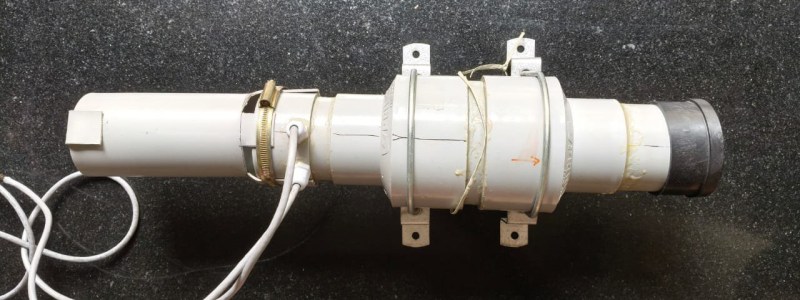Today in the submersibles department our hacker [Rupin Chheda] wrote in to tell us about their submarine project.
This sub is made from a few lengths of PVC piping of various diameters. There is an inflation system comprised of a solenoid and a pump, and a deflation system, also comprised of a solenoid and a pump. The inflation and deflation systems are used to flood or evacuate the ballast which controls depth. There are three pumps for propulsion and steering, one central pump for propulsion and two side pumps for directional control, allowing for steering through differential thrust. Power and control is external and provided via CAT6 cable.
We have covered various submarine projects here at Hackaday before and it is interesting to compare and contrast the designs. One sub we covered recently was this one made mostly from Lego. There are considerable differences in the approach to buoyancy, propulsion, steering, power, and control. Whereas the PVCSub uses separate ballast inflation and deflation systems the Lego sub uses one system that can be run forward or backward; whereas the PVCSub uses a pump for propulsion the Lego sub uses a magnetically coupled propeller; whereas the PVCSub uses differential thrust for steering the Lego sub uses a small propeller; whereas the PVCSub transmits power through external wires, the Lego sub has an onboard battery; and whereas the PVCSub uses the power wires for control the Lego sub is radio controlled.
Just goes to show that there are many ways to skin this particular kind of cat.















Cool, but really needs a demonstration. Its pretty easy to assemble to basic components of a ROV. Much harder to make it actually work and not flood with water. I notice for example that there is no provision to prevent the ballast suction pump from sucking water if you run it too long.
ATM, I have access to a small tank which I am using to test basic maneuvers, getting access to a pool is harder. A video demonstration is needed, I agree.
What ideas do you have to prevent the water from flowing inside the WTC?
I thought OceanGate mishap proved that cylinder-shaped submarines are a big no-no. You should only use spherical shapes because it has a determined safety equations and can be certified.
it makes me wonder how strong a submersible made entirely out of PVC would be if, proportionally, it had 2-foot-thick walls?
The pump that allows the submarine to rise can only generate max pressure of 12kg/cm^2. This corresponds to a depth of 16m. The pipe is rated for 16kg/cm^2, but given that it is in joints, I have safely taken a max depth of about 2-3 meters. The tether isn’t long enough to go any further without yanking/tugging on the operators hands.
There are tons of non-spherical submarines. See, for example, essentially all military subs.
Most submarines are not spherical, they are tubular. They are trying to go to those depths in carbon composite either. You don’t want sharp transitions in a pressure vessel, agreed but this isnt going very deep if connected to a cat 5 cable.
Really?
The OceanGate problem had nothing to do with the shape…
It had everything to do with incompatible project management for that kind of task.
That is the issue with assuming a business mindset is the correct one to solve every problem.
When the most important goal is money(making it or saving it) then corners are going to be cut that shouldn’t be. And when a failure means catastrophe, you can’t afford to do that.
Ever since seeing the spiral bound book ‘Build Your Own Underwater Robot’ by Harry Bohm at the Vancouver Aquarium gift shop, building something like this has been on the backburner…
https://a.co/d/6KOIkL6
I want to hunt invasive carp species in the Mississippi River and its tributaries with something small, robust, affordable, etc. can you please send me any suggestions?
Mask snorkel and a spear gun. Otherwise a bow and a reel. Or recently air gun powered spear gun. Like an air rifle but shoots arrows. Any way you do it it’s as fun as it is helpful. YouTube has many examples.